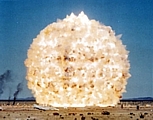Non-Nuclear Test Will Simulate Nuclear Weapon Strike
 Update (February 22, 2007): DTRA announces that Divine Strake has been canceled.
Update (February 22, 2007): DTRA announces that Divine Strake has been canceled.
The Defense Threat Reduction Agency (DTRA) today confirmed to FAS that the upcoming Divine Strake test widely reported in the media to be a non-nuclear event is in fact a low-yield nuclear weapons calibration simulation against an underground target.
A few, including Albuquerque Journal and disarmamentactivist.org, have speculated that Divine Strake was a nuclear-related event, but DTRA has up till now declined to confirm or deny the nuclear connection.
In response to an email earlier today, a DTRA spokesperson confirmed that Divine Strake is the same event that is described in DTRA budget documents as being a low-yield nuclear weapons shock simulation designed to allow the warfighters to fine-tune the yield of nuclear weapons in strikes on underground facilities.
It also turns out that Divine Strake is “an integral part” of STRATCOM’s new Global Strike mission, which is normally reported to develop mainly non-nuclear capabilities against time-urgent targets. Global Strike is one of the pillars of the Bush administration’s so-called New Triad which is said to be reducing the role of nuclear weapons.
According to a Department of Energy document associated with Divine Strake, the event comes only two years after President George W. Bush in Summer 2004 signed a presidential decision directive that ordered STRATCOM to “extend Global Strike to counter all [Hard and Deeply Buried Targets] to include both tactical and strategic adversarial targets.”
Divine Strake was not mentioned during last week’s Senate hearing on the Global Strike mission.
More: Divine Strake Background | Global Strike Chronology
The FY2026 National Defense Authorization Act (NDAA) paints a picture of a Congress that is working to both protect and accelerate nuclear modernization programs while simultaneously lacking trust in the Pentagon and the Department of Energy to execute them.
While advanced Chinese language proficiency and cultural familiarity remain irreplaceable skills, they are neither necessary nor sufficient for successful open-source analysis on China’s nuclear forces.
Satellite imagery has long served as a tool for observing on-the-ground activity worldwide, and offers especially valuable insights into the operation, development, and physical features related to nuclear technology.
This report outlines a framework relying on “Cooperative Technical Means” for effective arms control verification based on remote sensing, avoiding on-site inspections but maintaining a level of transparency that allows for immediate detection of changes in nuclear posture or a significant build-up above agreed limits.